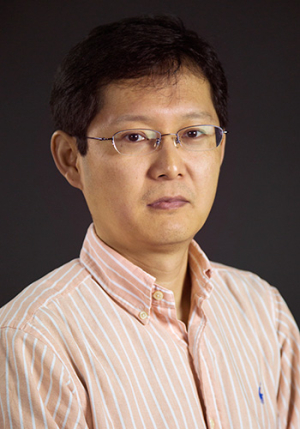Individuals suffering from devastating spinal cord injuries may one day benefit from research being conducted at the University of Houston Cullen College of Engineering.
Dong Liu, assistant professor with the college’s Department of Mechanical Engineering, recently won a $390,000 collaborative research grant from the National Science Foundation to develop a new treatment. He is working with fellow Cullen College professor Li Sun and researchers at the University of Texas Health Science Center at Houston led by Associate Professor Qilin Cao. Their efforts began with a seed grant from the Alliance for Nanohealth (ANH), a Methodist Hospital Research Institute-based organization dedicated to the development of clinical applications of nanotechnology.
When a spinal cord is damaged, the nerve fibers that transmit signals between the brain and the rest of the body can be too damaged to properly function, leading to paralysis. Unfortunately, these fibers, called axons, don’t regrow across the damaged area. Some researchers, then, are attempting to create artificial pathways that will spur axon regeneration.
Under this approach, surgeons aim to implant a polymer-based scaffold seeded with neural stem cells into a patient’s spine. This scaffold would literally act as a bridge connecting the two ends of the severed spinal cord. Ideally the stem cells would then turn into nerve cells and reconnect the cord.
The problem with this approach? It requires major invasive surgery on a patient who has already suffered a serious trauma, said Liu.
“You have to cut off a certain part of the damaged spinal cord, put the scaffold in and hope the stem cells grow in the right direction,” he said. “With this new method, we don’t need to arrange the stem cells in any physical bioscaffold. We put them in a solution because we want to inject them into the spinal cord.”
At the heart of this treatment are special iron oxide particles measuring approximately 20 nanometers (or twenty billionths of a meter). These particles have a unique property known as superparamagnetism. When they are exposed to a magnetic field, they themselves become tiny magnets, each with a north and south pole. Since these opposite poles are attracted to each other, the particles will naturally self-assemble into chain lattices along the direction of the applied magnetic field.
Liu, then, is developing a way to introduce the particles into adult stem cells. By doing so, he will be able to use a magnetic field to connect them and align them as a group into a position that reconnects the severed spinal cord.
Since these nanoparticles can be toxic, the first step is to coat them with synthetic or organic polymers such as dextran or proteins that prevent them from harming the cells. Liu will then enclose the coated particles in magnetoliposome, a lipid-based structure that is very similar in chemical makeup to the walls of stem cells. The magnetoliposome, however, has a positive charge, while the stem cells are negatively charged. The opposite charges draw the two together, while their chemical similarities allow the magnetoliposomes, along with the nanoparticles they contain, to easily pass through the cell wall.
“We let the stem cells engulf those liposomes. Since you have a magnetic force you can exert on the particles, if the particles are inside the cells you have a force you can exert on the cells and manipulate them, for example, to form stem cell chain along a specific direction.” said Liu.
Next, the modified stem cells will be put in a solution and injected into the patient near the injured area of the spinal cord. Doctors will then expose the area near the injection to a finely tuned magnetic field that should cause the stem cells to form a column that reconnects the two severed ends of the spinal cord.
Since this research is ongoing, the researchers have not determined exactly how long exposure to the magnetic field would have to last. Liu expects it could require several weeks for the formation of a strong and lasting connection and that a mobile magnetic field generator could be developed.
Those weeks, however, would pale in comparison to a lifetime of limited mobility or the long and difficult recovery from spinal surgery. “This work shows real promise,” said Liu. “If we’re successful, for many people paralysis could end up as just a temporary problem, not a lifetime condition.”
